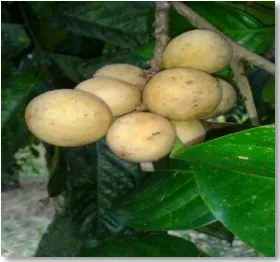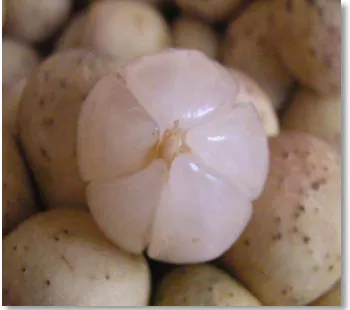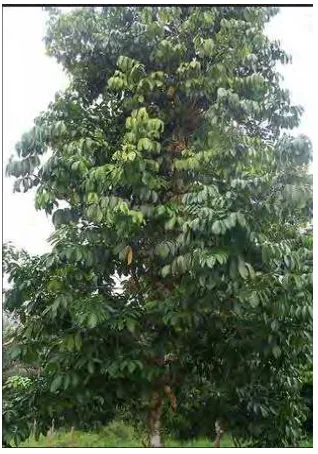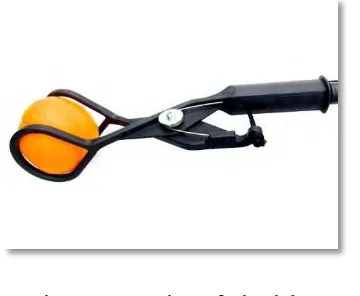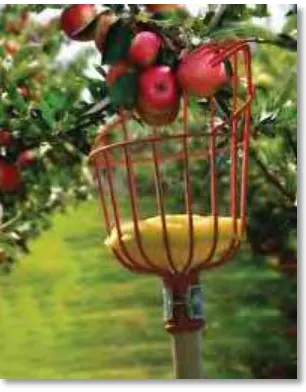i
SUPERVISOR DECLARATION
“I hereby declare that I have read this thesis and in my opinion this report is sufficient in terms of scope and quality for the award of the degree of
Bachelor of Mechanical Engineering (Design & Innovation)”
ii
DESIGN AND ANALYSIS OF LOCAL FRUIT’S POLE PICKER
NUR AIZATUL ‘AIN BINTI MD ZAHIR
This thesis is submitted as a part of the fulfillment for the bestowal of Bachelor in Mechanical Engineering (Design & innovation)
with honours.
Faculty of Mechanical Engineering Universiti Teknikal Malaysia Melaka
iii
DECLARATION
“I hereby declare that the work in this report entitle DESIGN AND ANALYSIS OF LOCAL FRUIT’S POLE PICKER
is my own except for summaries and quotations which have been duly acknowledged.”
Signature : ...
Author : NUR AIZATUL ‘AIN BINTI MD ZAHIR
iv
SPECIAL TO
Mom, Puan Atikah binti Ismail
A strong and gentle soul who taught me to trust in Allah, believe in hard work and that so much could be done with little. Thank you for guiding me as a person, teaching me that my job in life was to learn, to be happy, and to know and understand myself; only then could I know and understand others.
Dad, En Md Zahir bin Zainol
For earning an honest living for our family, for supporting and encouraging me to believe in myself, and who supported me emotionally and financially. I always knew that you believed in me and wanted the best for me.
Supervisor, Dr. Kamarul Ariffin
Who has been a constant source of knowledge and inspiration. I owe a debt of gratitude to you for your time and careful attention to detail.
Special Friends and housemates, Nor Ana, Fong Shon Feng, Nur Farah Izyan, Dayangku Siti Khadijah, Siti Najatul Aishah, and Nur Syafiqah
Thank you for listening, offering me advice, and supporting me through this entire process and general help and friendship were all greatly appreciated.
Another special friend, MKF,
v
ABSTRACT
vi
ABSTRAK
vii
TABLE OF CONTENT
CHAPTER TITLE PAGES
SUPERVISOR DECLARATION i
DECLARATION iii
ACKNOWLEDGEMENT iv
ABSTRACT v
ABSTRAK vi
TABLE OF CONTENT vii
LIST OF TABLES xi
LIST OF FIGURES xii
LIST OF APPENDICES xiv
LIST OF ABBREVIATIONS xv
CHAPTER I INTRODUCTION 1.1 Background 1
1.2 Problem statement 2
1.3 Objective 2 1.4 Scope 3
CHAPTER II LITERATURE REVIEW 2.1 Introduction 4
2.2 Lansium spp. 5
2.2.1 Generality of Lansium spp. 5
2.2.2 Development of Lansium fruit 6 and flower. 2.2.3 Factors and conditions for harvest 6
2.2.4 Characteristic of Lansium spp tree 7
viii
CHAPTER TITLE PAGES
2.3.1 Twister fruit picker 8
2.3.2 Pole Fruit Picker 9
2.3.3 WOLF GARTEN Fruit Picker 10
2.3.4 Hand-operated fruit picker 11 2.3.5 Combined tree saw, pruner and 12
paint sprayer
2.3.6 Fruit picker with stem cutting jaws 13 2.3.7 Hand-operated fruit picker 14 2.4 Overall review of existing product 15
2.5 Project design requirement 16
2.6 Design concept consideration 18
2.7 Design criteria
2.7.1 Ergonomics 19
2.7.2 Aesthetic 23
CHAPTER III METHODOLOGY
3.1 Introduction 24
3.2 Project requirement 24
3.3 Project flow chart 25
3.3.1 Literature review 26
3.3.2 Design concept 27
3.3.3 Concept selection 30
3.3.4 Detail design using Computer 32 Aided Drawing (CAD)
3.3.5 Material preparation 34
3.3.6 Fabrication 35
3.3.7 Analysis 36
CHAPTER IV RESULT AND DISCUSSION
4.1 Introduction 39
ix
CHAPTER TITLE PAGES
4.3 Quality Function Deployment
4.3.1 Engineering Characteristic 46
4.3.2 House of Quality 46
4.4 Product Design Specifications (PDS) 48
4.5 Morphological Chart 50
4.5.1 Concept Generation 51
4.5.2 Concept Screening 52
4.6 Conceptual Design 54
4.6.1 Concept 1 54
4.6.2 Concept 2 56
4.6.3 Concept 3 57
4.6.4 Best Concept 58
4.7 Material Selection 59
4.7.1 Lever 59
4.7.2 Cutting Tool 59
4.7.3 Pole 60
4.8 Structure Modelling 60
4.8.1 Numbering Part 63
4.8.2 Product Structure Tree 64
4.8.3 Product Structure Tree Cluster Assembly 68
4.9 Design Analysis 69
4.9.1 Deflection of Pole 69
4.9.2 Cutting Tool 72
4.10 Manufacturing Cost 75
4.11 Manufacturing Process Flow 79
CHAPTER V CONCLUSION AND RECOMMENDATION
5.1 Conclusion 80
x
CHAPTER TITLE PAGES
REFERENCES 82
APPENDIX A 84
xi
LIST OF TABLES
NO. TITLE PAGE
2.1 The optimum elbow angle 21
3.1 Evaluation Scheme for Design Alternatives of Objectives 31
3.2 Example of Weighted Decision Matrix 32
4.1 Licert’s scale 45
4.2 Customer requirements with weightage 45
4.3 Engineering characteristics 46
4.4 House of Quality for local fruit pole picker 47
4.5 Product Design Specifications 48
4.6 Morphological Chart 50
4.7 Concept Generation Chart 51
4.8 Concept screening for 6 concepts 53
4.9 Numbering Part 63
4.10 Cost Estimation for Prototype 77
xii
LIST OF FIGURES
NO. TITLE PAGE
2.1 Lansium spp. 5
2.2 The translucent pulp of Lansium spp. 6
2.3 Lansium spp. tree 7
2.4 Twister fruit picker 8
2.5 Pole fruit picker 9
2.6 WOLF GARTEN fruit picker 10
2.7 Hand operated fruit picker 11
2.8 Combined tree saw, pruner and paint sprayer 12
2.9 Fruit picker with stem cutting jaws 13
2.10 Hand operated fruit picker 14
2.11 Classification of the fruit pole picker components 18
2.12 Maximum grip strength vs. opening grip 20
2.13 Various elbows’ angle while performing task 21
2.14 Relationship between moment and perpendicular distance of pole picker 22
3.1 Project flowchart 25
3.2 Example of functional decomposition 29
3.3 Example of morphological chart 29
3.4 Example of detail design 34
3.5 Example of BOM 35
3.6 Example of CATIA structural analysis 36
3.7 Example of Finite Element Analysis 38
xiii
4.2 Types of mechanism preferred for fruit pole picker 41
4.3 Problem faced while using fruit pole picker 41
4.4 Types of problem faced while using fruit pole picker 42
4.5 Important factors for fruit pole picker 43
4.6 Way to cut the stem of the tree 43
4.7 The need to use the storage bag 44
4.8 The willingness to pay for the product 44
4.9 Standard Pole Picker in the market 52
4.10 Concept design 1 55
4.11 Concept design 2 56
4.12 Concept design 3 57
4.13 Best concept of pole picker 58
4.14 3D rough modelling 61
4.15 3D rough modelling isometric view 62
4.16 Equivalent System Diagram of Section of Pole 69 4.17 Angle of Operation and Resultant Force Components 71
4.18 Cutter plate/Cutting tool 72
4.19 Stress analysis on upper cutter 73
4.20 Material properties for upper cutter 73
4.21 Stress analysis on lower cutter 74
4.22 Material properties for lower cutter 74
4.23 Bill of Material 76
xiv
LIST OF APPENDICES
NO. TITLE PAGE
Appendix A Questionnaire and Gantt Chart 84
xv
LIST OF ABBREVIATIONS
HOQ - House of Quality
PDS - Product Design Specification WDM - Weight Decision Matrix CAD - Computer Aided Drawing
CATIA - Computer Aided Three Dimensional Interactive Application BOM - Bill of Material
1
CHAPTER I
INTRODUCTION
1.1 BACKGROUND
Malaysia is a country rich with varieties of local fruit such as rambutan, durian, mangosteen and dokong. Usually the homeowner or owner of a small farm retrieve the fruit by using homemade fruit pole picker climb on to a ladder and pick each fruit by hand. Certain types of fruit may be left to fall itself, but for the most species of local fruit, they must plucked or picked when they start to ripening to avoid the fruit dropping to the ground and creating a mess.
Thus, the purpose of this project is to design and analysis of local fruit picker with mechanical design knowledge in order to maintain the quality and quantity of the fruits. The common fruit pole picker has a pair of cutting tool such as scissors with a stationary and movable member join together to cut the fruit stem there between.
2
are conducted in order to verify the design and to increase the performance of this fruit picker.
1.2 PROBLEM STATEMENT
Nowadays, there are many alternative to collect the ripen fruit from the trees. One of the popular methods is by using the fruit picker. Current fruit picker comes in different method and mechanism of handling and operation which is some of them is too complex to be handled by single person. Unfortunately, there still some problem faced by user such as difficulties to pick fruit at the unreachable and hidden area because it cannot be maneuvered between the bushes. Fruit picker at the market has limited capability or function to pick certain type of fruits. Besides that, current fruit picker cannot ensure the quality of picked fruit especially for fruit that easily loose from their benches which can cause obvious permanent fruit damage.
Smaller pole picker have also been proposed since the common pole picket in the market seems too bulky and have certain disadvantages in terms of weight and storage. Even though most of the pole pickers are able to separate the fruit from the stem, some of them are failing to separate between ripe and unripe fruit which will cause waste.
1.3 OBJECTIVE
To done this project successfully, there are several objectives are targeted to achieve the project goals.
i. To study the problem and identify the solution with current fruits picker terms of safety, ergonomic and cost.
3
iii. To perform the stress analysis on the design in order to make comparison with the existing fruit pole picker in the market.
1.4 SCOPE
Based on project objectives, there are four scopes that have been narrowed down and identified which are:
i. To study the advantages and disadvantages of existing fruit pole picker in the market and suggest the solution to the previous design.
ii. To propose the conceptual design with suitable mechanism in order to develop the efficient cutting mechanism to cut the fruit stem.
iii. To develop the fruit pole picker that is ergonomic, safe and easy use by reducing the weight and simple enough to be hand held and manually operated by a person.
4
CHAPTER II
LITERATURE REVIEW
2.1 INTRODUCTION
This chapter is divided into seven sections which the first section are focusing on the characteristic of Meliaceae family of Lansium spp. fruit such as dokong, langsat and duku, second section focusing on the existing fruit picker in market with the research patent, the third section focusing on review of existing product, the forth section focusing on the project design requirement ,the fifth section focusing on design concept consideration and the last section focusing on design criteria of fruit pole picker. In order to identify the effective ways to plucking the fruit, the characteristic of the fruit such as the color, chemical composition, harvesting index, weight of the fruit should be studied and understood. For the existing product and research patent section, the method used and the disadvantages for every product will be determined and explain in this chapter.
2.2 LANSIUM SPP.
5
of Lansium spp tree. These aspects need to be study in order to identify the suitable design concept to retrieve the Lansium spp fruit.
2.2.1 Generality of Lansium spp.
There are three important cultivars of Lansium spp which are dokong, langsat and duku. According to Yunus et al (1998), the identification among these cultivars is nearly the same thus make it difficult to growers to classify based on their morphological appearance Lansium spp has almost seedless fruits with a brittle skin and size of 30 to 60 mm in diameter. The skin of young fruit is pale green and, when it starts to ripening it turns yellow with some brown spots while its sap is no longer sticky. The green seed is covered with white translucent pulp. Recently, many researchers and growers have shown interest in plantation of Lansium spp fruit as a new important economic crop that is gaining popularity in Malaysia. Some information on colour and composition of dokong are reported by Yunus et al (1998). According to Yunus et al (1998), the best indicator for determining the maturation of dokong is the change in their colour since the degree of yellowness at different stages is easy to recognize. Norlia (1997) state that dokong fruit start to develop yellow colour about 87 days after fruit set and Yunus et al (1998) state that dokong can be harvested 11-17 days after that stage. Figure 2.1 shows that the Lansium spp fruit.
6
2.2.2 Development of Lansium fruit and flower
The Lansium spp tree bears flowers on 1 – 8 inflorescences arising from floral cushions on main branches. Each inflorescence is 15- 2- cm long bearing 20 – 50 hermaphrodite flowers measuring about 6mm across, which develop into nearly spherical shaped fruits. According to Pungtip (2009), the green seed of Lansium spp is covered with white translucent pulp and the skin of immature fruit is pale green and, when ripe, its turn yellow with some brown spot while its sap is no longer sticky. Figure 2.2 shows the translucent pulp of Lansium spp.
Figure 2.2 The translucent pulp of Lansium spp. (Source: Azman, 2010)
2.2.3 Factors and conditions for harvest
7
2.2.4 Characteristic of Lansium spp tree.
The Lansium spp tree is average in size about 30 metres in height and 75 centimeters in diameter. The tree is tall with densely clustered leaves but with advance of agricultural technology, the Lansium spp tree is much shorter nowadays. The leaves are very similar to rambutan fruit trees which are an oval shaped. The trunk grows in irregular manner with the roots showing above the ground and the tree’s bark is a greyish in color. Figure 2.3 below shows the example of Lansium spp tree in Malaysia.
Figure 2.3 Lansium spp tree (Source: Simple Malaysian, 2007)
2.3 COMPARISON OF CURRENT PRODUCT AND RESEARCH PATTERN
8
a hand pole which is by ‘shearing’ or ‘pulling’ mechanism at the end of the pole in order to separate the fruit from the tree. Many advantages have been notice in order to help in the development of the final concept design. A copy of all pattern discussed is attached in appendixes.
2.3.1 Twister fruit picker
This twister fruit picker in Figure 2.4 is a new innovation to quickly, easily and safely pick the fruit. The mechanism involved in this design is rotating mechanism.
Figure 2.4 Twister fruit picker
(Source: Global Products & Development, 2013)
Advantages
9
Disadvantages
The spring action to rotate the fruit is too strong thus for the weak hand person, not enough tension will be applied when hold the fruit to pull. This design consumed a lot of time since it can only pick one fruit at one time.
2.3.2 Pole Fruit Picker
This fruit picker in Figure 2.5 is about 13 foot long consist of static and durable fiberglass pole which perform grab and pull action. This pole picker usually use when fruit is picked from tress instead of off the ground.
Figure 2.5 Pole fruit picker. (Source: John and Sue Weaver, 2012)
Advantages
